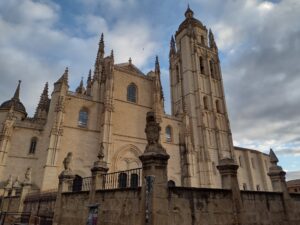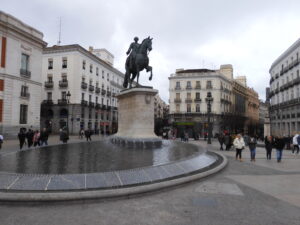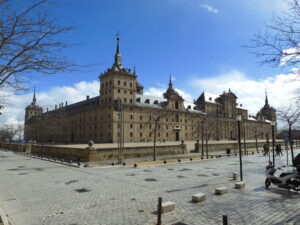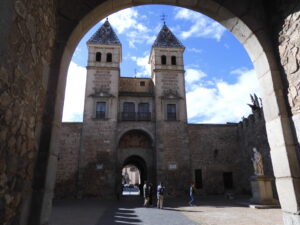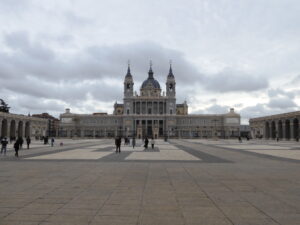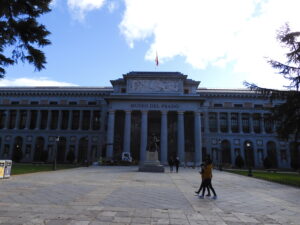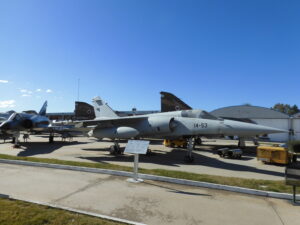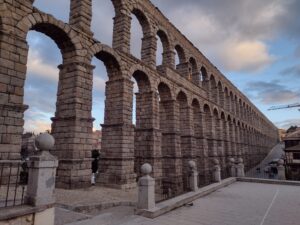Spain
Madrid Travel Tips
As mentioned in the trip overview, my selection of Spain as a visit location came about almost entirely due to the low fare I found using Google flights. This trip was a pretty simple one week out and back, basing out of Madrid. I made day trips to El Escorial, Toledo and Segovia. Those were all easily done from my base in Madrid due to the availability of a robust public transportation system. In the weeks leading up to the trip, I watched travel videos, reached out to friends who had been to Madrid, and did internet research on what I might want to see when I arrived. I left with a list of things I wanted to see. I treated this not as a checklist that I had to complete, but as a ready supply of things I knew I would be interested in doing. Of course, there were other pop-up opportunities that I discovered once I was in Madrid. You might say I applied the old Air Force adage, “flexibility is the key to air power.” I ended up seeing nearly all of the items on my list while taking in a few others, one of which was a Real Madrid game that I saw on the schedule after I had arrived.
As European countries go, Spain is on the larger side. The high speed rail schedule seems so good that I think you could fly into Madrid and go to just about any major Spanish city using high speed rail. Flights to Barcelona don’t seem significantly more expensive than those to Madrid, but coming into Madrid and connecting via rail is probably a good option if you’re going to Seville or some other large Spanish city. It would probably even work to go to Portugal, if the airfare to Lisbon was substantially more. There are a lot of options for getting around Spain. Although I found it to be less expensive generally than England, France, or the Netherlands, it is still Europe. It isn’t a bargain.
Knowing some Spanish helps. Madrid is thick with tourist sites. In such places there are usually some English speakers around. I speak low-intermediate Spanish. I had some difficulty understanding the Spanish accent, which sounded a lot more lispy than Latin American Spanish. When I tried to get Spanish speakers to slow down for me, the usually just gave up and tried to speak English with me rather than deal with my Spanish. Reading Spanish, the other hand, is not any more difficult in one part of the world than another. I found it interesting to learn the people living around Barcelona proudly speak Catalan rather than Spanish, though most also speak Spanish. I met some who made quite a show of letting me know Spanish was not their primary language.
Money
Spain converted to the Euro over twenty years ago. As a coin and currency collector, I found this a little sad. I figured I might find some leftover pesetas cheap somewhere since they were now virtually worthless. This proved not to be the case, and I ended up paying a small premium to purchase some valueless 19th and 20th century coins from a dealer.
Euros are easily found. I used my standard procedure of finding an ATM soon after arrived to acquire all I needed. This works find as long as you have an ATM card that doesn’t punish you for foreign transactions. While the bills are lackluster, Euro coins do offer a few opportunities for collectors. While the coins are uniform in size and composition from one country to the next, they do have country specific designs on one side. Although you find a vast majority of Spanish designed Euro coins in Spain, the ubiquity of Euro coins means that coins from other countries circulate in all nations that use the currency. Collectors can find country designs of any Euro adopting country in any other. I did grab some coins from other EU nations while in Spain. They are still kind of boring, though.
Transportation
Since I was staying in a major European city with a robust public transportation system, I never even really investigated renting a car. I don’t know if it would be cost effective or not. Madrid’s metro system is easy to navigate, and relatively inexpensive. The metro itself joins a suburban rail system, and a longer distance high speed train that can get you to any other major city in Spain from Madrid in about three hours or less. When basing out of Madrid, there is no reason to use anything other than the public transportation. There are also buses in Madrid, but I never had to take them as the metro and rail systems took me everywhere I needed to go, with the exception of Quatro Vientos, and for that I used Uber, which is readily available in Spain. The only drawback to Madrid’s public transportation system is that you pay a very hefty fee to get to and from the airport. This airport public transportation tax is pretty common, though. You will also pay extra to get a cab or an Uber if the trip involved the airport.
Accommodations
My experience with rooms in Spain was very limited. The best deal I found when shopping was for an AirBnB. It was not cheap, but it was less expensive than low budget motels. I did not shop hostels. My room was very basic. It had heat, air, hot water, and a bed. There was not even a full set of sheets. This set me back about $60 U.S. per night, and was probably the best I could have done for a private room. I likely could have cut the cost roughly in half by going the hostel route. Sometimes a private room is nice, though.
Food
There are a few unique components to Spanish cuisine. Spain is noted most for tapas bars. Tapas are orders of things like appetizers that come with enough to serve several people. This is a bit of a problem for solo travelers. If I ordered a tapa, it always came with enough food to make it a full meal for me. Tapas are so named because they are often served under some kind of lid. The idea is that you go around from one bar to the next with your friends, snacking as you go. I did try a few, and did not find most of them to be spectacular.
Spain is also famous for paella, a rice dish infused with seafood. It is very tasty, but tends only to be served at lunch time, and I don’t usually eat big lunches while traveling. I had difficulty finding paella until I finally found one restaurant that would serve it for supper. It was good, and I wish it had been available more often. Bocadillos were another situational specialty. Nearly everyone at the Real Madrid game I went to had one. These were mostly dry sandwiches in a hard baguette like roll. I was not early enough or savvy enough to bring a bocadillo to the game, but I grabbed one right before I took my two hour train ride back to Madrid the last night I was in Spain. I do not like dry sandwiches, and the bread was so hard it cut the inside of my mouth. I think I will pass on them next time I come to Spain.
I enjoyed the manchego cheese I found. I did not end up getting any at the manchego cheese museum in La Mancha, but it was available in other places. I tried some lamb while out in the neighboring towns, but it was tough – more like mutton than lamb. I tested a kind of Castilian soup that was o.k. Albondegas were just o.k., meatballs with tomato sauce. Patatas bravas are a kind of tapa made from potatoes that were pretty good. The much ballyhooed jamon seemed overrated to me. It was dry and salty. I did not sample the notorious roast baby pig that is supposed to be so tender you can cut it with a plate. That’s something you can try in Toledo. I found an Argentinian steak house one night that was pretty good.
My favorite Spanish specialty food come from Andalusian restaurants. Andalusia was held by the Moors for longer than much of the rest of Spain. The food was often rice based, but had some North African or almost Arabic spices in it that gave it extra flavor, regardless of what exactly I ordered. There were Andalusian restaurants everywhere I went. They were easy to find.

